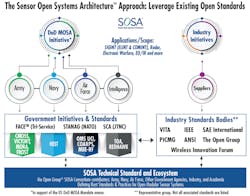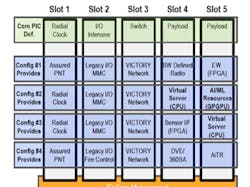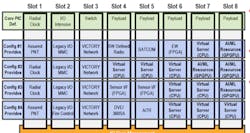Open Standards Drive Flexibility in Defense System Designs
What you’ll learn:
- What is MOSA?
- How SOSA and CMOSS are related to MOSA.
- The elements of a SOSA Technical Standard-aligned system.
The open-standards approach to defense electronics has made great strides in recent years. Helping to drive the accelerated adoption of open architectures, such as the OpenVPX module and backplane architecture overseen by the VITA trade association, is the Modular Open System Approach (MOSA) memo issued by the U.S. Department of Defense (DoD) in January 2019. The memo, supported by the U.S. Army, Navy, and Air Force, mandates that all new systems “shall be designed and developed, to the maximum extent practicable, with a modular open-system approach to enable incremental development and enhance competition, innovation, and interoperability.”
Specific mandates for MOSA now reach down to the Program Executive Office (PEO) and Program Manager (PM) level, and requirements for and interest in MOSA solutions continues to grow rapidly. This mandate was also codified into law (Title 10 U.S.C. 2446a.(b), Sec 805), requiring all new defense acquisition programs to be designed and developed using MOSA.
MOSA Expectations and Compliant Standards
For designers of military sensor systems, the MOSA-aligned standard leverages modular design and widely supported, consensus-based, non-proprietary standards for key interfaces that are expected to:
- Accelerate fielding of new capabilities
- Reduce integration cost and risk
- Streamline development
- Simplify modernization and sustainment
- Mitigate obsolescence challenges
- Facilitate interoperability and reuse
- Enable rapid composition of capabilities from conformant elements
Examples of open standards that satisfy the MOSA mandate and the services for which they’re most relevant include:
- CMOSS: C5ISR/EW Modular Open Suite of Standards
- SOSA: The Open Group Sensor Open Systems Architecture (Fig. 1)
- FACE: Future Airborne Capability Environment
- HOST: Hardware Open Systems Technologies
- MORA: Modular Open Radio Frequency Architecture
- OMS/UCI: Open Mission Systems/Universal Command and Control Interface
- VICTORY: Vehicular Integration for C4ISR/EW Interoperability
The CMOSS architecture, which enables hardware commonality across ground vehicles, focuses on a network-centric approach to communications. It enables a transition from dedicated boxes for specific functionalities, referred to as line-replaceable units (LRUs), to the more flexible and cost-effective line-replaceable module (LRM) approach in which a rugged chassis hosted in the vehicle can be integrated with a mix of different boards to provide and introduce needed functionalities and technologies (Fig. 2).
The LRU approach to CMOSS delivers significant size, weight, power, and cost (SWaP-C) benefits, such as simplified integration with less cabling and fewer peripherals. The use of open systems also eases technology refresh and insertion, plus it helps deliver common hardware across echelons and platforms to reduce the logistics burden.
SOSA Standard
The SOSA Technical Standard is based on the hardware foundation of CMOSS. The definition of the standard is overseen by The Open Group SOSA Consortium, which empowers government and industry to collaboratively develop open standards and best practices. While the U.S. Army maintains control of CMOSS, it and SOSA are highly complementary.
With its emphasis on interoperability, the SOSA Technical Standard will provide system designers the flexibility to choose best-of-breed solutions. The soon-to-be-released SOSA Technical Standard 1.0 will include third- party conformance validation to ensure compliance to the open standard. Because SOSA isn’t subject to International Traffic in Arms (ITAR) regulations and not restricted to the U.S., its benefits can be realized worldwide.
The SOSA Technical Standard leverages and complements open standards in government and industry. It defines architectural modules (containing functions and behaviors) with defined open interfaces, enabling the development of capabilities made up of common components. The standard incorporates specifications for hardware elements including electrical and mechanical interfaces composing the SOSA sensor element.
With its foundation in CMOSS, SOSA defines VPX slot profiles. The resulting LRMs are connected via Ethernet, so that slots can be placed in the most convenient locations in the platform, eliminating the need to co-locate chassis.
Today, required combat platform functions and sensors are integrated as discrete boxes, such as positioning, navigation, and timing (PNT); Mission Command (JBC-P); SINCGARS Radio; Jammer (EW); IP Radio; and Intel Data Processing systems. With SOSA, these functions can be integrated onto single or multi-function VPX modules and housed in a rugged VPX chassis with either five or eight slots (Figs. 3 and 4, respectively). Data flows are defined by system software and the use of network-centric architecture principles.
While SOSA defines both 3U and 6U plug-in cards (PICs) as system building blocks, most industry activity and interest have been for the smaller module size. Both sizes of LRM require +12-V power. While leveraging VITA’s OpenVPX architecture, SOSA aims to foster interoperability by defining every signal pin on the standard PICs, thus eliminating the “user-defined” pins that have driven proprietary system designs. Platform-specific interfaces are confined to special user-defined modules, allowing for easy future upgrades to the processing and networking infrastructure.
The standard also calls out VITA 48.2 2-Level Maintenance (2LM) and VITA 47 environmental reliability. PIC profiles are provided for I/O-intensive single-board computers (SBCs), payload modules for processing (with 40-GbE and PCIe connectivity) and switch profiles that enable modules to communicate to each other via Ethernet, PCIe, and RF/optical switching. Radial clock modules also are defined to time-align processing elements and support positioning, navigation, and timing (PNT).
Leading COTS suppliers currently offer modules that were developed in alignment with the SOSA Technical Standard. For Curtiss-Wright, CMOSS and SOSA provide an opportunity to minimize program risk with field-proven hardware. Single point-of-contact integration services and expertise enable customers to reduce the complexity of developing CMOSS/SOSA solutions while fully leveraging the many benefits of these open standards.
SOSA Modules
In addition to the MPMC-933x three-slot SOSA-aligned chassis, Curtiss-Wright has produced a range of SOSA-aligned and field-proven modules, with many more in development. Examples of currently available CMOSS/SOSA 3U OpenVPX building blocks include:
- VPX3-1260: An Intel-based processor card for advanced processing and various C5ISR applications that offers variants aligned to both I/O-intensive and payload profiles.
- VPX3-1707: An Arm-based processor card that offers high performance per watt in systems optimized for size, weight, and power (SWaP), and is aligned to the I/O-intensive profile.
- CHAMP-XD1S: A digital signal processor (DSP) featuring high performance and hardened security for compute-intensive applications, and is aligned to the I/O-intensive profile (Fig. 5).
- VPX3-4935: An NVIDIA Quadro Turing-based GPGPU board for intense processing and artificial intelligence (AI) in high-performance embedded-computing (HPEC) systems. The board, which is aligned to the 3U VPX A-PNT Timing Card designed to enable assured positioning, navigation, and timing (A-PNT), simplifies the integration of complementary PNT sources and is aligned to the radial clock profile.
- VPX3-663: A hybrid switch module that combines PCIe Gen 3.1 and 10G Ethernet switching in a single 3U VPX module and is aligned to the expansion/control plane switch profile.
- VPX3-687: A fully managed and versatile Ethernet switch optimized for both low-latency control-plane and high-throughput data-plane applications, aligned with the data/control plane switch profile.
The defense electronics industry looks forward to the release of SOSA Technical Standard 1.0. It promises a new era of open standards-based system integration with flexibility and interoperability as its hallmarks. With broad support across the government and industry, the availability of numerous offerings from multiple vendors will help deliver today’s most advanced sensor-processing system technologies more rapidly and cost-effectively to our warfighters.





